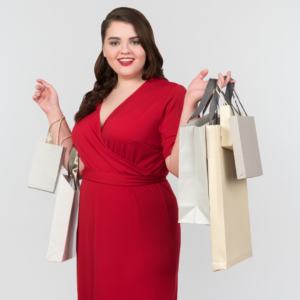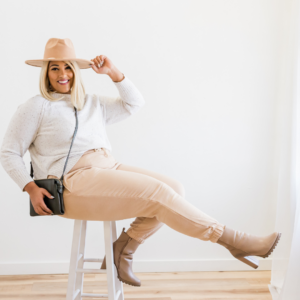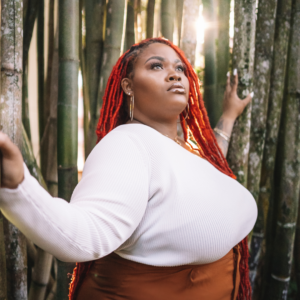In 2021, Old Navy made waves by announcing their intent to combine their plus size line with their core product offerings. The initiative, called Bodequality, led to stores carrying sizes 0-30 in a wide selection of designs. However, less than a year later, the company backpedaled. The fast fashion retailer still features a full range of offerings online, but the ease and accessibility of shopping in-store for larger sizes was short lived.
The experiment seemed to illustrate what many designers fear when venturing into the plus size category; the company cited spatial constraints and low demand for certain sizes which led to excessive inventory and increasing overhead.
But is what Old Navy encountered the only thing keeping designers from creating clothing marketed to plus sized customers? To find out, we have to look beyond a few assumptions about the fashion industry and perhaps envision a solution or two of our own.
 What is Plus Size anyway?
What is Plus Size anyway?
Before tackling the problem of sizing, it’s wise to define what we mean by plus sized fashion. There is ongoing discussion among consumers, retailers, and even health professionals (!) about what size marks the beginning of the plus size category. Designers may take liberties with the term as well, in the name of inclusivity.
Many clothing lines sell only up to a size 12, but according to the U.S. Department of Health and Human Services, the average woman in the US wears a size 16 or an XL. Plus sized models are women wearing size 12 and up. In big box retailers, the Women’s Department often encompasses sizes 12-18. Middle sizing bridges the gap from traditional to plus sizes, and presents its own set of challenges. (We plan to unpack the “middle size mystery” in an upcoming article.)
It comes in my size, but does it fit?
In a recent newsletter on the topic, designer and expert patternmaker Alison Hoenes used the example of a basic t-shirt, a familiar and relatively shapeless design. On a small body with little curve or depth, it looks like it is designed to: it lays fairly flat over the chest and back, with few folds or places where the fabric is stretched or pulled, and the back and front hems remain parallel to the floor. On a larger sized body with a larger sized shirt from the same pattern, the front panel rides up to cover the bust and stomach areas, drag lines appear at the bust and armholes, and there is excess fabric at the back waist. Simply making shirts bigger doesn’t guarantee they fit, or that they look good enough to inspire confidence in the wearer.
Variation in plus sized bodies is one of the challenges designers and technical patternmakers face when creating pieces in larger sizes. “Ideal” plus sized models used in patternmaking and runway modeling are hourglass shaped with flat stomachs, small waists and wide hips (and usually young with little yield to the muscle tone). Their shapes rarely account for normal characteristics like back rolls, belly fat, and broad hips.

Unfortunately, most patternmaking systems use the idealized versions as the foundational “fit model” from which structural style decisions are made. When you move away from stretchy materials and into more structured garments and fabrics, it’s quite possible that what is designed to fit one size 18 person will not actually look good on another size 18 person because the darts (seams) may not be in the right place to support the shape underneath. Larger sizes of bodies are generally just more pronounced versions of standard body shapes (pears, apples, etc) but clothing makers are nervous about designing for curves.
Did you know that there has never been a formal textbook written for plus size pattern drafting? Shockingly, no one has taken the time to document the theories and geometric rules that would teach future generations how to think about larger sizes as a starting point rather than a scale-to endpoint.
However, this is not to say that plus size people should limit themselves to shapeless or unfashionable garments. We love the recent trend of #StyleNotSize that shows fashion-forward looks side by side on different sized women. And designers like Christian Siriano proves over and over that curvy women look stunning when someone takes the time to solve for their unique body.
In some cases, there also exists the erroneous assumption that a person who wears a larger size will want to disguise their supposed flaws instead of showcasing their fabulous body. A lot of plus sized clothing is shapeless, not just to accommodate a wider range of features like thick thighs or wider shoulders, but to hide them. Frustratingly, this attitude hints at the assumption that being plus size is a temporary state of being, one brought on by (sudden, unwanted) weight gain, pregnancy, or even menopause. Not all plus sized bodies are transitional ones!
Three reasons why designers don’t design for plus sized bodies
The prevailing narrative is that designers do not create clothing for larger bodies because it costs more, but the reasons often go much deeper. Understanding these challenges helps address the hurdles associated with inclusive sizing.
The discussion can be broken down into 3 main arguments:
- Fabric and other overhead costs: At the core of the “fat tax” argument is the belief that costs go up just because dressing larger bodies uses more fabric. While it can be true that more fabric is required, and expensive fabric may increase the cost of production, the true costs go beyond materials. For clothing to fit the way it’s intended in large sizes, designers need to adjust the design or ultimately rethink how the pieces are constructed. Creating new patterns takes time and leads to higher overhead costs. And because much of our patternmaking is done in Asian countries (where population data suggests smaller bodies are the majority), there may not be access to plus size patternmaking expertise or data.
- The market isn’t there: This is another argument that is misunderstood. First of all, the market is most definitely there ($194B and growing). But as Old Navy learned, while plus sized people make up about half of shoppers, their bodies are unique. The plus size category encompasses a large range of sizes, and covering just a handful of these sizes doesn’t account for the entirety of the market. Additionally, most mass manufacturers force clothing brands to buy a minimum order quantity (MOQ) for each size to keep the cost per piece low. It is cost prohibitive for many brands to invest in a “risky” production run with potentially higher return rates than standard sizes because of the body variability, so they just do the bare minimum.
- Luxury designers don’t want plus sized people wearing their clothing: Sadly, this one isn’t a myth. Some retailers, especially high-end luxury brands, prefer to keep their sizes small to cultivate exclusivity and define attractiveness through the idealized image of a perfect body. “No one wants to see curvy women,” fat phobic fashion designer Karl Lagerfeld once quipped. “The world of beautiful clothing is about dreams and illusions.”
In an interview with Salon, former Abercrombie & Fitch CEO Mike Jeffries was credited as saying, “A lot of people don’t belong [in our clothes] and they can’t belong. Are we exclusionary? Absolutely.”
To the surprise of many, Abercrombie reinvented itself in 2017 under CEO Fran Horowitz. The company now carries a wide array of sizes in stores and online, including short, tall, and long lengths, as well as the “Curve Love” line, which adds an extra two inches of room in the thighs. The new mission statement is clear: “Abercrombie isn’t a brand where you need to fit in —it’s one where everyone truly belongs.”
 Where designers fear to tread
Where designers fear to tread
While the majority of consumers will agree that retailers and designers need to step up their game when it comes to sizing, there is a lack of industry collaboration and training for solutions. Achieving the desired look across all sizes requires designers to think big, invest capital, and to reconsider their approach to fitting and the construction of garments. They might have to consider rethinking their size charts in a way that technology can help turn data and feedback into machine learning.
And the retail/fashion business models themselves need a refresh; instead of punitive retail pricing for plus sizes, a slight increase in pricing for all items can help absorb the increased costs of research and production. Over time, as we learn and share approaches to complex bodies, the costs will naturally come down.
As Beyonce reminded fashion designers at the Council of Fashion Designers of America Awards in 2016, “You have the power to change perception, to inspire and empower, and to show people how to embrace their complications, and see the flaws, and the true beauty and strength that’s inside all of us.”
Of course, we’re a little biased here at Balodana, but we think custom clothing is the best possible way to achieve a style that helps you look and feel incredible no matter what your shape or size. But even we admit that it’s an ongoing conversation with our designers, because they are often working with limited data and patterns. We always suggest that you send them pictures of your body from the front and side; since they can’t get hands-on with you, they need visual references to understand how your bones and muscles and fat are distributed.
Savvy plus sized shoppers can benefit from purchasing investment pieces from made-to-measure designers, then supplementing their wardrobe with thrifted pieces, tailored garments, and one size fits all accessories like scarves and jewelry.
A few pieces that we LOVE for all bodies include:
This hip neon pink skirt with box pleating from Samshek is perfect to pair with blazer and tank top or even a button down.
A custom made tank top by Delia Von Hahn is the perfect base for any wardrobe!
Forget the sweats and grab a pair of fully customizable loose fit navy linen pants from Summisura.
References
https://www.vox.com/the-goods/2019/2/19/18231624/karl-lagerfeld-death-controversy-fat-comments-adele
https://www.salon.com/2006/01/24/jeffries
https://www.byrdie.com/plus-size-abercrombie-essay-5221084
https://www.refinery29.com/en-us/2021/08/10615815/what-is-considered-plus-size-fashion-model
